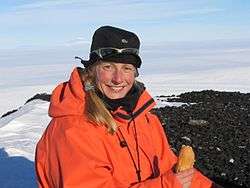Joanne Johnson
| Joanne Johnson | |
|---|---|
 | |
| Born | 1977 |
| Nationality | British |
| Fields | Polar Geologist |
| Institutions | British Antarctic Survey |
| Alma mater |
BSc University of Durham PhD University of Cambridge |
| Notable awards |
BAS Laws Prize, Marie Tharp Fellowship |
Joanne Johnson (born 1977, Birmingham, UK) is an British geologist and prominent Antarctic scientist, currently working for British Antarctic Survey in the 'Palaeoenvironments, Ice Sheets and Climate Change' team.[1] Johnson joined British Antarctic Survey in 2002. She is best known for her work on glacial retreat,[2] and is the namesake of the Johnson Mesa in James Ross Island, Antarctica.[3]
Early life and education
Johnson decided to follow a science career after particularly enjoying studying science subjects at King Edward VI High School in Birmingham during her teenage years. In 1998, Johnson obtained a BSc. Hons. Geology (1st class) at the University of Durham (Hatfield College). She then went on to complete a PhD in 2002, supervised by Sally A Gibson at the University of Cambridge (Clare College), with a thesis "Magmatism of the Vitim Volcanic Field, Baikal Rift Zone, Siberia". The research consisted of using geochemical characteristics of lavas to study the composition and thickness of the lithosphere in the Baikal Rift Zone of Siberia, and to improve understanding of the melting regime beneath the region during the Cenozoic.[4]
Career and impact
After her PhD, Johnson began work at British Antarctic Survey. The first project she worked on (2002–2005) was an analysis of the origin and implications of authigenic alteration minerals in volcaniclastic rocks from James Ross Island.[5] In 2005–2009, she worked in the QWAD (Quaternary West Antarctic Deglaciation project, within the GRADES (Glacial Retreat in Antarctica and Deglaciation of the Earth System) programme at BAS, reconstructing Quaternary thinning history of Pine Island Glacier.[2] Her work showed that Pine Island Glacier thinned as rapidly 8000 years ago as it is at the present-day.[6][7]
For 2015–2020, Johnson is working on a NERC funded project "Reconstructing millennial-scale ice sheet change in the western Amundsen Sea Embayment, Antarctica, using high-precision exposure dating", with a team from BAS, Imperial College (London), Durham University, Columbia University (USA) and Pennsylvania State University (USA).[8] She is also working on other projects including "Exploring feedbacks between glaciation, volcanism and climate in Antarctica: studying CO2 outgassing from the James Ross Island lavas using melt inclusions in olivines", "Determining Quaternary glacial history of the Lassiter Coast, Antarctica", "Comminution dating boundary conditions: A study of (234U/238U) disequilibrium along the Antarctic Peninsula", and "Antarctic Peninsula exhumation and landscape development investigated by low-temperature detrital thermochronometry".
Awards and honours
Johnson was awarded the British Antarctic Survey Laws Prize in 2008[9] and the Columbia University, Marie Tharp Fellowship for 2010–2011.[10] The three-month fellowship allowed Johnson to collaborate with scientists at Lamont-Doherty Earth Observatory and yielded work published in the journal, Science.[11] She has spoken about the challenges of doubling as a scietist and mother: "The hardest thing is being torn between your personal and professional ambitions…Wanting to go to conferences, but not wanting to leave your children. Having to leave work early or drop everything if you get a phone call that she's sick. You could be in the middle of a complicated thought process and you have to start again."[10]
In January 2007, due to the impact of Johnson's work (which also led to a completely novel proxy for recognising past ice sheets using alteration mineral chemistry), the UK Antarctic Place-Names Committee named a feature on James Ross Island, Antarctica after her. Johnson Mesa, James Ross Island, Antarctica (63° 49'40"S, 57° 55'22"W) is a large flat-topped volcanic mountain north of Abernethy Flats, between Crame Col and Bibby Point on Ulu Peninsula, James Ross Island.[12][13]
Selected works
- Joanne Johnson – British Antarctic Survey". bas.ac.uk. N.p., 2016. Web. 25 July 2016. Available from: https://www.bas.ac.uk/profile/jsj/.
- Joanne Johnson And Lamont-Doherty, Collaborating On Glacial Research | Lamont-Doherty Earth Observatory". ldeo.columbia.edu. N.p., 2016. Web. 25 July 2016. Available from: http://www.ldeo.columbia.edu/news-events/joanne-johnson-and-lamont-doherty-collaborating-glacial-research.
- Johnson, J.S., Bentley, M.B., Smith, J.A., Finkel, R.C., Rood, D.H., Gohl, K., Balco, G., Larter, R.D., Schaefer, J.M., 2014. Rapid thinning of Pine Island Glacier in the early Holocene. Science 349, 999–1001. doi:10.1126/science.1247385.
- Johnson, J.S. & Smellie, J.L., 2007. Zeolite compositions as proxies for eruptive palaeoenvironment. Geochemistry, Geophysics, Geosystems 8, Q03009, doi: doi:10.1029/2006GC001450.
- Johnson, J.S., Gibson, S.A., Thompson, R.N., Nowell, G.M., 2005. Volcanism in the Vitim Volcanic Field, Siberia: Geochemical Evidence for a Mantle Plume Beneath the Baikal Rift Zone. Journal of Petrology 46, 1309–1344. doi:10.1093/petrology/egi016.
References
- ↑ British Antarctic Survey. "Joanne Johnson". British Antarctic Survey. Retrieved 27 July 2016.
- 1 2 "Research highlights". Nature. 452 (7184): 130–131. doi:10.1038/452130a.
- ↑ "Johnson Mesa". Mapcarta. Retrieved 2016-08-22.
- ↑ Johnson, J.S., Gibson, S.A., Thompson, R.N., Nowell, G.M (2005). "Volcanism in the Vitim Volcanic Field, Siberia: Geochemical Evidence for a Mantle Plume Beneath the Baikal Rift Zone". Journal of Petrology. 46 (7): 1309–1344. doi:10.1093/petrology/egi016.
- ↑ Johnson & Smellie (2007). "Zeolite compositions as proxies for eruptive palaeoenvironment". Geochemistry, Geophysics, Geosystems. 8 (3): n/a. Bibcode:2007GGG.....8.3009J. doi:10.1029/2006GC001450.
- ↑ Johnson; et al. (2014). "Rapid thinning of Pine Island Glacier in the early Holocene". Science. 343 (6174): 999–1001. Bibcode:2014Sci...343..999J. doi:10.1126/science.1247385.
- ↑ "Millennia of Melting: New Research Confirms Antarctic Thaw Fears". spiegel.de. Der Spiegel. 2014. Retrieved 2016-08-22.
- ↑ Joanne Johnson and British Antarctic Survey. "ANiSEED – AmuNdsen Sea Embayment Exposure Dating". British Antarctic Survey. Retrieved 19 August 2016.
- ↑ British Antarctic Survey Club. "The Laws Prize". British Antarctic Survey Club. Retrieved 28 July 2016.
- 1 2 Joanne Johnson And Lamont-Doherty. "Collaborating On Glacial Research". Lamont-Doherty Earth Observatory. Retrieved 27 July 2016.
- ↑ Johnson; et al. (2014). "Rapid thinning of Pine Island Glacier in the early Holocene. Science". Science. 349 (6174): 999–1001. Bibcode:2014Sci...343..999J. doi:10.1126/science.1247385.
- ↑ "Meeting of the Antarctic Place Names Committee" (PDF). apc.antarctica.ac.uk. British Antarctic Survey. 2006.
- ↑ "Glacial landsystems on James Ross Island". Retrieved 2016-08-22.